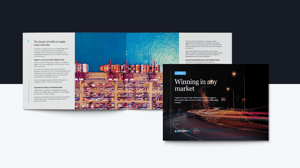Automotive market disruptions are converging and industry leaders are facing a unique blend of volatility and opportunity.
The automotive industry has faced a series of shifts and shocks in recent years. The recent announcement of a 25% tariff on vehicles imported into the U.S. was only the latest in a series of market disruptions. Consumers and OEMs alike are navigating feast-or-famine supply, an estimated $127 billion in misallocated dealer inventory, and extended ownership cycles which are putting pressure on aftermarket parts and service.
On the other hand, with an estimated 33% of buyers deferring purchases, that means two-thirds of buyers are still actively shopping. This is creating a path forward for savvy, data-driven automotive leaders.
Recently I teamed up with Steven Silver from Publicis Sapient to dig into these issues and opportunities in a webinar hosted by Automotive World. In case you missed it, I'll summarize the key themes in this post, including how OEMs, dealers, and suppliers can leverage AI-powered forecasting, connected data, and digital supply chain strategies to stay competitive and customer-centric.
Automotive supply chains are stuck at a crossroads
The automotive industry is stuck in a feast-or-famine cycle. A persistent and latent disconnect between supply and demand is often exacerbated by:
- Raw material constraints and global transportation disruptions
- Inventory misalignment and excess holding costs
- Lagging responsiveness in demand and supply planning
- The complexity of managing extended customer life cycles
These challenges are then compounded by siloed supply chain planning and execution systems that fail to provide the speed or visibility that automotive companies need to get ahead and stay ahead.
Four strategic priorities to drive forward
To turn the corner once and for all, we shared a playbook specific to the automotive industry around four strategic pillars—each one a lever for driving agility, revenue, and customer trust:
1. Win a greater share of in-market buyers
Instead of leaning solely on demographics, top performers are identifying high-value, less price-sensitive customer segments using behavioral and intent data. With AI-powered pricing optimization and rapid incentive deployment, one OEM moved 33,000 vehicles in just 30 days—by targeting current owners and accelerating replacement cycles.
2. Hold on to your best prospects and customers
As ownership cycles extend, customer engagement strategies must evolve. Unified CRMs, automated nurture programs, and lifecycle-specific messaging are helping companies maximize the $140,000 lifetime value of a single customer. Even marginal gains in retention can yield major ROI when powered by integrated insights and predictive analytics.
3. Double down on aftersales & service
With service margins as high as 70–85%, the aftersales experience is a critical revenue stream. Yet many small and mid-size dealers lack the tools to support seamless service interactions. Digital platforms for scheduling, communication, and payments are becoming essential for extracting every dollar of value—and building customer loyalty.
4. Win the recovery faster
The COVID-19 pandemic taught the industry the importance of early warning signals. Market intelligence dashboards can now provide alerts tied to macroeconomic indicators, competitive pricing shifts, and inventory incentives—enabling faster, more precise action across customer-facing teams.
Integrate customer intelligence with supply chain data for unified decision-making
The path forward doesn't stop at understanding and shaping what consumers are shopping for. Better customer intelligence, better customer service, and the ability to adapt to market conditions must tie back to your end-to-end supply chain—from strategy through execution.
It starts with visibility—not just into your Tier 1 suppliers, but across the extended supply chain. You need to know where raw materials and components come from, what capacity and constraints exist across each node, and how geopolitical, climate, and economic disruptions could affect their availability. With this complete picture in mind, then you can then model different network scenarios, optimize flows, and make more resilient supply chain decisions.
But visibility alone isn’t enough. The next step is to ensure that customer intelligence is directly informing the supply chain planning process. That means:
-
Connecting point-of-sale and inventory data into demand forecasting
-
Incorporating live retail trends, regional differences, and promotions performance
-
Aligning product assortment and pricing strategies with operational feasibility
We’ve seen major automotive players invest heavily in commercial analytics, while their supply chain planning still runs on outdated assumptions — often based on what was built last month. To break this cycle, companies should consider adopting AI-enabled planning tools that can:
-
Match demand to supply based on real-time constraints (labor, materials, capacity)
-
Shorten production “time fences” so plans can adjust more dynamically
-
Prioritize where and when to produce based on actual customer need
On the execution side, agility is key. Even the best plans drift. Savvy leaders are using supply chain execution systems that can detect when reality deviates from expectations and trigger action. That includes real-time alerts when actual output diverges from forecasts as well as cross-functional coordination to pivot quickly across planning, production, and logistics.
Ultimately, all of this drives toward one goal: The ability to make reliable promises to customers. When you can commit to a delivery date — and follow through — it builds trust, drives loyalty, and strengthens the brand.
Key takeaways for automotive supply chain leaders
- Data agility is the new differentiator. Organizations that can sense and respond to change quickly are outperforming their competitors.
- AI isn’t just hype—it’s driving results. From pricing to planning, AI is enabling faster, more precise decisions.
- Service is a goldmine—if done right. High-margin service experiences need digital enablement to be fully realized.
- Small steps beat big delays. Iterative improvements in data, planning, and personalization are better than waiting for a full transformation. Focus on building your AI and data-driven capabilities iteratively.
- Cross-functional integration is no longer optional. Unified views across customer and supply chain data unlock smarter strategies and stronger performance.
Keep it going: Watch the on-demand webinar
If you want to dive deeper into the strategies and examples that we shared, I hope you'll take a few minutes to watch the free on-demand webinar. And if you would prefer to talk to someone on our team, don't hesitate to reach out. We are here to help you and your organization can take the next step toward a more resilient, data-driven future.




